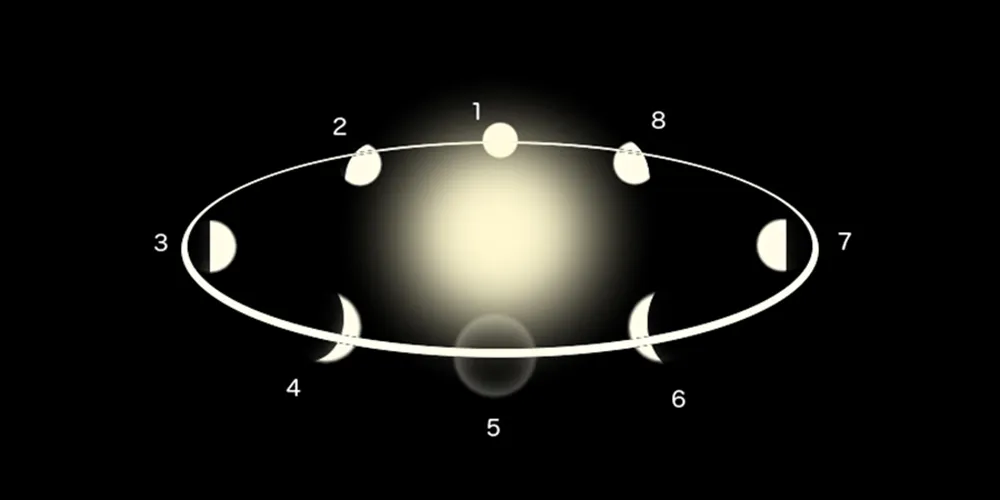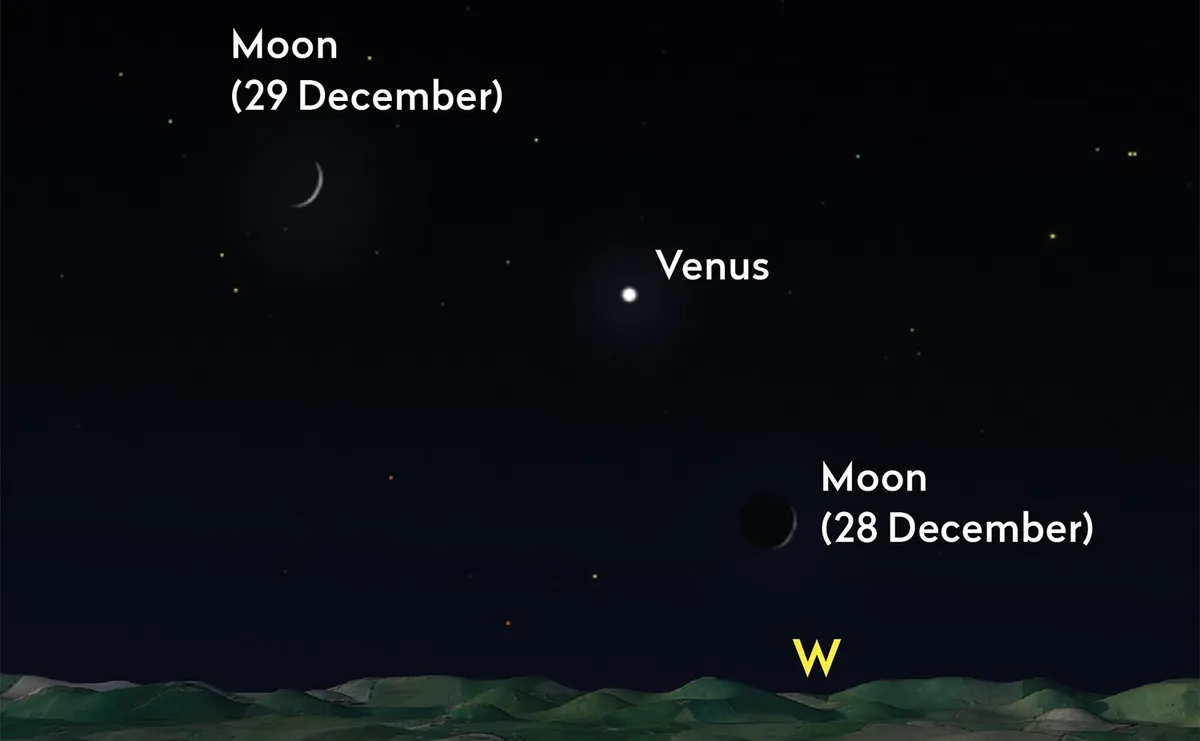Perhaps by now you have noticed the brilliant star low down in the south west at sunset. This is the bright planet Venus, our closest planetary neighbour in space. Venus will be prominent in our evening skies throughout December 2019 and will climb higher in the sky, getting larger and brighter during January and February 2020.
Both Mercury and Venus are classed as inferior planets. This doesn't mean we think of them as lesser objects, rather it means that they are closer to the Sun than we are.
In contrast, superior planets are those whose orbits lie beyond the earth, Mars Jupiter and the rest of the Solar System.
The appearance of inferior planets in our skies is quite different from the superior ones.
You may have noticed that Mars, Jupiter and Saturn are present in the sky for most of the night when they are well placed, but both Mercury and Venus only ever appear in the morning sky or the evening skies.
The periods of time for which inferior planets are visible are called elongations and there two types:
- When Venus (or Mercury) is on the eastern side of the Sun in the sky, it is visible in the evening sky and we call this an eastern elongation.
- When the planet is on the western side of the Sun it appears in the morning sky and this is called a western elongation.
The path of Venus around the Sun

Venus shows distinctive phases as it orbits the Sun. At times it appears gibbous, at other times it may appear as a crescent.
Galileo was the first person to observe the phases of Venus with his small refractor and a good pair of binoculars will certainly show them.
We can see the reason for this. The diagram above shows various positions of Venus in its orbit as observed from Earth.
Starting at position 1, the Sun lies directly between the Earth and Venus and the planet is said to be at superior conjunction.
It usually lies too close to the Sun to be observed at this time. After conjunction, Venus will start an Eastern elongation and will appear low down in the evening sky, this is currently the case.
The planet will continue to move towards us (position 2 on the above diagram) and as it comes closer the phase decreases and it starts to appear larger.
Look out for Venus in the evening sky in December and, if you take the time to observe the planet every night, you'll notice it climbing higher in the sky, getting larger and brighter during January and February 2020.
On 24 March 2020, Venus will reach the furthest separation possible from the Sun. This point is called greatest eastern elongation.
By now the phase has notably decreased so that by 26 March it appears to be half illuminated (looking like a half Moon). This is the time of Dichotomy (position 3).
This is a great time for observation as the planet is visible for around three hours after sunset!
Venus will continue to move towards us but it is starting to 'fall' back towards the Sun.
By position 4 it appears as a crescent in binoculars or a telescope and has a very large apparent size. On 28 April it will be at its greatest brilliance.
The planet will eventually pass between the earth and the Sun - this is called inferior conjunction (position 5) - on 3June 2020.
After this point Venus moves into the morning sky and we will have moved into a western elongation.
The cycle continues with Venus moving away from us (position 6) but now the phase is increasing.
Dichotomy will be reached (but with the other side of Venus illuminated) in position 7.
The planet will start to appear gibbous once more (position 7) until eventually it reaches superior conjunction and the whole sequence starts again.

How can I observe Venus in the night sky?
Venus is very easy to spot with the unaided eye as it is so brilliant. It often joins other astronomical bodies in the night sky and it can be fun to catch these events, since all you need is a clear sky (easier said than done!)
For example:
- On the evenings of 10 and 11 December, Venus lies close to the planet Saturn.
- On the evenings of 28 and 29December, the planet will be near the Moon.
Telescopically it is often said that Venus is dull, but this is not the case!
All we are seeing is the top layer of clouds but even a small telescope will show the phase and faint cloud markings.
The cloud details can be hard to see but those people more sensitive to the bluer colours will find them.Venus's cloud markings come out particularly well in UV images.
The best time to observe Venus is in the twilight. The planet is actually quite hard to observe against a dark sky as the glare washes out all of the fainter cloud markings.
Try finding the planet when the Sun has just set (make sure the Sun is below the horizon before searching for it with binoculars or a telescope, as viewing the Sun without specialist equipment could seriously damage your vision!)
Most telescopes these days come with colour filters - these filters normally screw into the bottom of the eyepiece and have a number printed on the side for identification.
A yellow filter is a good one to use visually as it cleans up the image and helps boost the contrast of the features.
Cloud markings may be easier when viewed with a blue filter. You may notice that the cloud markings look a little different in a blue filter say compared to a red one.This is because the filter is showing you different depths of Venus' atmosphere.
Another point of interest is the phase anomaly. It is the case that the observed phase of Venus is usually slightly less than the predicted phase. This is due to the Schröter effect.
In theory the planet should appear half illuminated on 26 March, but you might well find telescopically that it appears to be a little more than that due to the phase anomaly.
Actual dichotomy may occur a good few days later.

Recording Venus
I can't emphasise enough how important it is to record your observations! To this day I still follow the advice given to me by the late Sir Patrick Moore and have a separate notebook for each planet.
Your notebook should be made of good quality paper, be hard backed and bound properly (rather than spiral bound).
For each observation you should record the date, time (in UT), telescope and seeing conditions.
You can make a drawing of Venus by using a 50mm circle - simply draw in the phase and sketch in any cloud markings you have seen.
You can make a drawing at the telescope, and make sure you note the time of the drawing. If you use a filter, record which one you have used.
There are many benefits to doing this. Firstly, you will have a proper written record of what you have observed over the course of the elongation.Secondly, you will be able to see how you have improved over time.
You will be able to see which magnification works best for you with the telescope you use, what filters help to bring out the cloud details and so on.
Most importantly, it turns your observing session from a casual one into a structured one.
This is important because you will find you will engage with the planet more if your sessions have focus.
Not all elongations of Venus are equal; however the current eastern elongation is going to be great for UK-based observers.
The planet will reach a reasonable altitude in our skies and will be a great target for observers for much of the first part of 2020.
It's nice to finally have a bright well placed planet in our evening skies!
